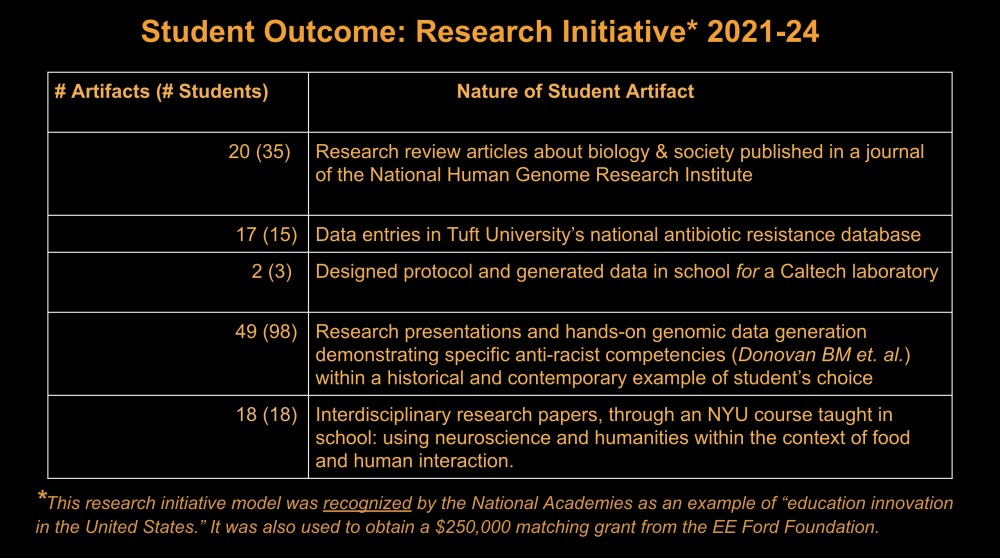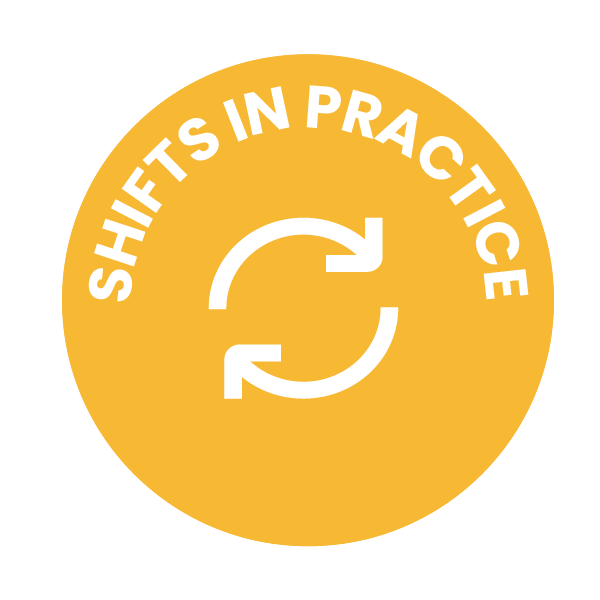A Real World Value-Based Model for Student Well-Being
Will students thrive if their learning involves making a valuable contribution to the real world?
Mattering, a measure of student well being, academic and emotional, relative to a space or people increases when students make a valuable contribution (France & Finnley, 2010). Described below is a model that creates time and space for high school students to add value to the real world. The implementation challenges, solutions and growth of the model in Polytechnic School are highlighted.
Challenge 1: Convincing the school to implement the model
Solution: Present the model in sequential phases to demonstrate its feasibility and mission, and to provide students multiple ways to add value.
Phase 1: In 2021, a year-long Biological Research (BR) course was proposed with a focus on developing competencies within the context of real-world projects. There were two highlights:
The opportunity to add value to the National Human Genome Research Institute (NHGRI) by publishing research reviews in its journal.
To build anti-racist value by engaging with data, both from the research literature and through hands-on experiments, that has been shown to reduce cognitive racial bias and increase action towards social justice in school students (Donovan BM, 2016, 2019).
Phase 2: In the summer of 2022, a Summer Research (SR) program was piloted to test the projects of the BR course and provide students with sustained research experience through longer continuous working hours, professional feedback and the opportunity to publish data.
Phase 3: Later in 2022, building on outcomes from phase 1 and 2, the Poly Research Initiative (PRI) was proposed and approved by the school wherein students could formally choose from the BR and SR courses, and two new courses:
Senior Biological Research (SBR) for students from BR and/or SR to further deepen their research skills
Neuroscience & Humanities: Food (NHF): using food as a lens and drawing from neurobiology, world history, and the diversity of local cultures, students explore human interaction, adding value by collecting oral histories. Note that sustained engagement with lived experiences from diverse cultures significantly increases Openness to Diversity and Challenges, a measure of intercultural competence required in the real world (Shim & Perez, 2018), and is strongly influenced by exposure to diversity in the pre-college years (Bowman & Denson, 2012).
Measures of Growth:
Value added by students to the real world from 2021-2024 through the BR, SR, SBR and NHF spaces are shown in Table 1 in terms of number and nature of artifacts produced and the number of students who produced it.
The model was recognized by the National Academies as an example of “education innovation in the United States.” It was used to get a $250,000 grant from the EE Ford Foundation to support students and faculty; and presented to the school’s Board of Trustees to successfully raise matching funds from donors.

Table 1
Challenge 2: Convincing students and parents to consider the culture of developing real world skills
Solution: Present the following learning outcomes to students and parents:
Generating a portfolio of artifacts demonstrating proficiencies in real world skills relative to scores.
Using artifacts to describe the process of learning: what they had to do to produce it, where they are, where they want to go and how to get there.
Design thinking, and interaction with professionals to get feedback on the rigor of producing an artifact of real world significance.
Knowing how real world competencies connect with those required by and cultivated by desired college programs.
Growth: The number of students enrolled in the PRI and parents who support it have grown. All students from the first graduating class have been admitted into college programs, many with a research focus. Student feedback from the BR, SR, SBR and NHF spaces are hyperlinked.
Challenge 3: Partnering with real world spaces that allow students to make a contribution to their workflow while compatible with the school’s schedule and budget.
Solution: Start with simple projects that use real world methods and resources while having other more advanced projects in the pipeline being researched and developed.
Adding a summer component helps students run long experiments or research projects without the constraint of the regular school schedule and creates a foundation they can build on when they return to school after the summer (SBR). As students go through this sequence, it allows for making a rigorous and sustainable contribution to a real world space (Table 1).
Design research spaces like a university lab or another real world setting in terms of having a focus that provides students with multiple independent tracks to make a real-world contribution and relies on low-cost, high quality workflows that fit within the school’s curriculum and budget. An example is the antibiotic resistance project that makes a contribution to the national database at Tufts University and the microbiology project that makes a contribution to the California Institute of Technology.
Many of the spaces mentioned in Table 1 are accessible to any school to use and develop further. Importantly, they represent a window for new spaces to be designed informed by a school’s access to local resources, specifically tapping into the parent and alumni community.
The Model’s Call to Action
- Address need for developing real world student competencies while nurturing student well being and connecting to the school's Portrait of a Graduate.
- Build anti-racist and intercultural competencies for students to thrive in a global world and strengthen the school’s DEI mission.
Partner with the real world to create mutually beneficial, well-integrated and sustainable learning spaces.
Future Outlook and Acknowledgements
The future outlook of the research initiative model depends on:
The curation of a diversity of spaces that allow students to add real world value, directly strengthened by a national network of schools that develop and share these resources.
The scalability in terms of implementing the model for under-resourced schools.
I thank Polytechnic School led by John Bracker and the real world partners for their support, and, I thank the students for enlivening the model through their work
Balakrishnan Selvakumar is the Founding Director of the Biological Research Initiative at Polytechnic School and Editor-in-Chief of the National Human Genome Research Institute’s journal, Genomics Insights.
For more, see:
- Belonging Beyond the Bell
- Creating Spaces for Dialogue That Matters: World Cafe
- What Is the Role of School Leaders in Nurturing Collective Purpose?

This post is part of our Shifts in Practice series, which features educator voices from GOA’s network and seeks to share practical strategies that create shifts in educator practice. Are you an educator interested in submitting an article for potential publication on our Insights blog? If so, please read Contribute Your Voice to Share Shifts in Practice and follow the directions. We look forward to featuring your voice, insights, and ideas.
GOA is a nonprofit learning organization that reimagines learning to empower students and educators worldwide. In partnership with our global network of 150 schools, we provide interactive, relationship-driven courses, expert resources, and innovative thinking that help to expand and elevate academic programs. Together, we help students and educators become open to the extraordinary.
Follow us on LinkedIn for the latest learning opportunities and news. Sign up for GOA Insights, our newsletter focused on innovative ideas and best practices for the future of learning. Become a Member School.
